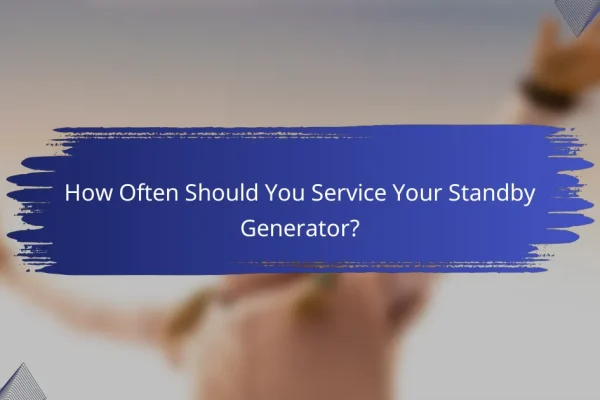What are the best practices for standby generator maintenance?
Best practices for standby generator maintenance include regular inspections and servicing to ensure optimal performance and longevity. Following a consistent maintenance schedule can prevent unexpected failures and costly repairs.
Regular oil changes
Changing the oil in your standby generator is crucial for maintaining engine health. Typically, oil changes should occur every 100 to 150 hours of operation or at least once a year, whichever comes first.
Use high-quality oil that meets the manufacturer’s specifications. Regular oil changes help reduce engine wear and keep the generator running smoothly.
Battery checks and replacements
Regularly checking the battery is essential for reliable generator operation. Inspect the battery terminals for corrosion and ensure connections are tight.
Batteries should be tested every six months and replaced every 2 to 5 years, depending on usage and environmental conditions. A weak battery can lead to failure during a power outage.
Fuel system inspections
Inspecting the fuel system ensures that the generator has a clean and reliable fuel supply. Check for leaks, and ensure that fuel filters are replaced according to the manufacturer’s recommendations.
In addition, consider using a fuel stabilizer if the generator is not used frequently, as this can help prevent fuel degradation and maintain engine performance.
Cooling system maintenance
The cooling system is vital for preventing overheating during operation. Regularly check coolant levels and inspect hoses for leaks or wear.
Flush and replace the coolant every two years to ensure optimal cooling efficiency. This practice helps avoid engine damage and extends the life of the generator.
Exercise the generator monthly
Exercising the generator monthly helps keep it in good working condition. Run the generator for about 30 minutes under load to ensure all components function properly.
This practice helps to prevent fuel stagnation and allows you to identify any issues before they become serious problems. Regular exercise also keeps the battery charged and the engine lubricated.
How often should you perform standby generator maintenance?
Standby generator maintenance should be performed regularly to ensure reliability and efficiency. Generally, basic checks are recommended every six months, while a comprehensive service should be conducted annually.
Every 6 months for basic checks
Every six months, perform basic checks to keep your standby generator in good working condition. This includes inspecting the oil level, checking the battery charge, and ensuring that the air filter is clean. Regularly testing the generator under load can also help identify any potential issues early.
Make a checklist for these basic checks to streamline the process. Common items to include are:
Oil level
Battery condition
Coolant level
Air filter cleanliness
Annually for comprehensive service
An annual comprehensive service is essential for the long-term performance of your standby generator. This service should include a thorough inspection of all components, including fuel lines, electrical connections, and the exhaust system. Additionally, changing the oil and replacing the oil filter are critical steps in this process.
Consider hiring a qualified technician for the annual service to ensure that all aspects are properly addressed. This can prevent costly repairs down the line and extend the lifespan of your generator significantly.
What are the signs that your standby generator needs maintenance?
Signs that your standby generator requires maintenance include unusual noises, frequent power outages, and warning lights on the control panel. Addressing these issues promptly can help ensure reliable performance and longevity of the generator.
Unusual noises during operation
If your standby generator is making unusual noises, such as grinding, rattling, or excessive humming, it may indicate a mechanical issue. These sounds can be a sign of loose components, worn bearings, or other internal problems that require immediate attention.
Regularly listening for changes in the operational sounds can help you catch potential issues early. If the noises persist, it’s advisable to consult a professional technician for a thorough inspection.
Frequent power outages
Experiencing frequent power outages while your standby generator is in use may signal that it is not functioning properly. This could be due to a variety of factors, including fuel supply issues, electrical faults, or a failing battery.
To mitigate this, ensure that the generator is adequately fueled and that all connections are secure. If outages continue, consider scheduling a maintenance check to diagnose the underlying cause.
Warning lights on the control panel
Warning lights on the control panel of your standby generator are clear indicators that something is amiss. These lights can signal issues such as low oil pressure, overheating, or battery failure.
Refer to the generator’s manual to understand the specific meanings of each warning light. Addressing these alerts promptly can prevent further damage and ensure your generator operates effectively when needed.
What are the costs associated with standby generator maintenance?
The costs associated with standby generator maintenance can vary widely based on service frequency, type of generator, and specific repairs needed. Regular maintenance typically ranges from a few hundred to over a thousand dollars annually, depending on the complexity of the system and the services performed.
Average service costs in the US
In the United States, average service costs for standby generators usually fall between $150 and $500 per service visit. This can include routine inspections, oil changes, and filter replacements. Some providers may offer annual maintenance packages that can help reduce costs over time.
For comprehensive maintenance, including testing and load bank services, costs can rise to $1,000 or more annually. It’s advisable to compare service providers and consider their reputation and the services included in their packages.
Cost of replacement parts
Replacement parts for standby generators can vary significantly in price, depending on the component and the generator model. Common parts like batteries, oil filters, and spark plugs may cost anywhere from $20 to $200. More critical components, such as alternators or control panels, can range from several hundred to a few thousand dollars.
It’s essential to use manufacturer-approved parts to ensure compatibility and maintain warranty coverage. Keeping an inventory of common replacement parts can also help minimize downtime and repair costs.
Long-term savings from regular maintenance
Investing in regular maintenance for standby generators can lead to substantial long-term savings. Well-maintained generators are less likely to experience major failures, which can be costly to repair. Regular servicing can extend the life of the generator, potentially saving thousands in replacement costs.
Additionally, routine maintenance can improve fuel efficiency and performance, leading to lower operational costs. Setting up a maintenance schedule can help ensure that your generator remains in optimal condition, ultimately providing peace of mind and financial benefits over time.
How to choose a standby generator maintenance service?
Choosing a standby generator maintenance service involves evaluating their qualifications, reputation, and pricing. Focus on finding a provider that meets industry standards and has a solid track record of customer satisfaction.
Check for certifications and licenses
Ensure that the maintenance service has the necessary certifications and licenses to operate in your area. This often includes compliance with local regulations and industry standards, which can vary by region.
Look for certifications from recognized organizations, such as the National Fire Protection Association (NFPA) or the Electrical Generating Systems Association (EGSA). These credentials indicate a commitment to safety and quality in service delivery.
Read customer reviews and testimonials
Customer reviews and testimonials provide insights into the reliability and quality of the maintenance service. Check online platforms like Google, Yelp, or specialized service review sites to gauge customer satisfaction.
Pay attention to recurring themes in reviews, such as punctuality, professionalism, and problem-solving capabilities. A service with consistently positive feedback is more likely to meet your expectations.
Compare service packages and pricing
When comparing service packages, look for comprehensive offerings that include routine inspections, emergency services, and parts replacement. Some companies may offer tiered packages based on the level of service you require.
Pricing can vary significantly, so obtain quotes from multiple providers. Consider not just the cost but also what is included in each package. A slightly higher price may be justified by better service or additional features.
What tools are needed for DIY standby generator maintenance?
For DIY standby generator maintenance, essential tools include basic hand tools, safety equipment, and specific maintenance items. Having the right tools ensures effective upkeep and can help prevent costly repairs.
Basic hand tools
Basic hand tools such as wrenches, screwdrivers, and pliers are crucial for routine maintenance tasks. These tools allow you to tighten loose connections, replace parts, and perform general inspections. It’s advisable to have a complete set to handle various tasks efficiently.
Additionally, a multimeter can help diagnose electrical issues, while a torque wrench ensures that bolts are tightened to the manufacturer’s specifications. Regularly check these tools for wear and replace them as needed to maintain their effectiveness.
Safety equipment
Safety equipment is vital when performing maintenance on standby generators. Always wear safety goggles and gloves to protect against debris and sharp edges. Hearing protection is also recommended, especially when operating the generator or using power tools.
Ensure that your workspace is well-ventilated to avoid inhaling harmful fumes. Having a fire extinguisher nearby is a good precaution, as generators can pose fire risks if not maintained properly.
Maintenance items
Specific maintenance items include oil, filters, and spark plugs, which are essential for keeping your generator running smoothly. Regularly changing the oil and filters can extend the life of your generator significantly. Check the manufacturer’s guidelines for the recommended types and intervals for these items.
It’s also wise to stock up on replacement parts, such as belts and hoses, to minimize downtime during maintenance. Keeping a maintenance log can help track when these items were last replaced, ensuring timely upkeep.












